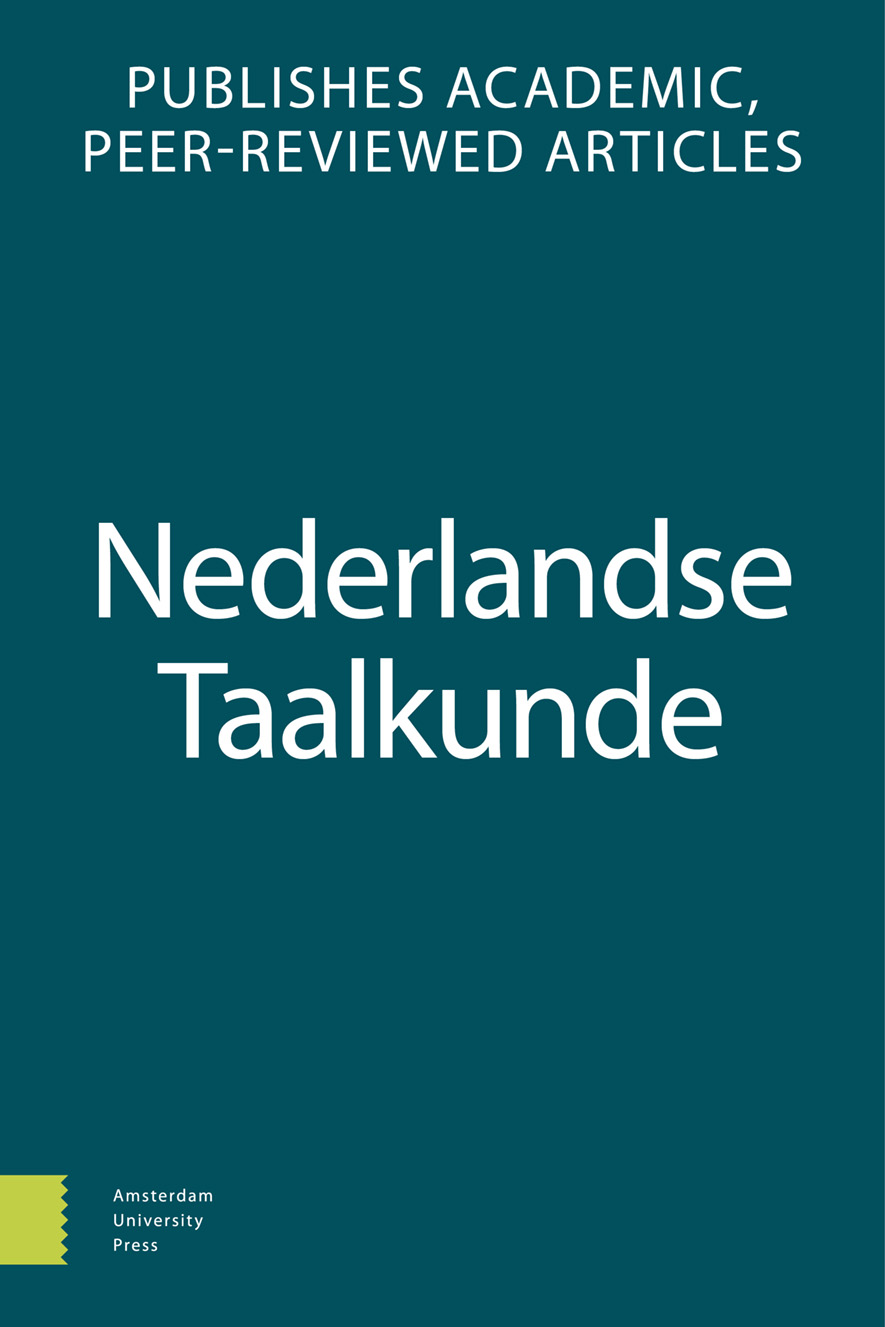- Home
- A-Z Publicaties
- Nederlandse Taalkunde
- Previous Issues
- Volume 24, Issue 1, 2019
Nederlandse Taalkunde - Volume 24, Issue 1, 2019
Volume 24, Issue 1, 2019
-
-
Waarom zou een zin geen twee voorzetselvoorwerpen kunnen bevatten?
Meer MinderDoor Ina Schermer-VermeerAbstractIn the last two decades there has been a debate about the question whether a simple clause can contain more than one prepositional object. In this paper, I argue that the underlying grammatical model plays a decisive role in opting for either one or two prepositional objects, as becomes clear in the discussion between Vandeweghe and Broekhuis. Moreover, following Vandeweghe, I claim that simple clauses indeed can contain two prepositional objects if the relationship of each of the two objects to the predicate is different.
-
-
-
Waarom (ik denk dat) een deelzin slechts één voorzetselvoorwerp kan bevatten
Meer MinderDoor Hans BroekhuisAbstractSchermer-Vermeer (this volume) claims that grammatical models have played a decisive role in answering the question as to whether a simple clause may contain more than one prepositional object. Although I believe that theoretical considerations can be very useful in deciding among competing hypotheses, this reply article shows that Schermer-Vermeer is wrong in arguing that my earlier conclusion that there can be at most one PP-object in a clause is forced upon me by two hypotheses found in (certain versions of) the generative framework, namely (i) the unaccusativity hypothesis and (ii) the hypothesis that verbs can take at most two internal arguments.
-
-
-
Dialectologie en Nederlandse zinsbouw*
Meer MinderAbstractDialectology and Dutch syntax
This paper argues for a closer collaboration between Dutch dialect syntax research on the one hand and the synchronic study of Standard Dutch grammar on the other. The central claim is that a thorough grasp of morphosyntactic variation in Dutch dialects can substantially enrich both the description and the analysis of Standard Dutch sentence structure. Three case studies are presented in support of this claim: Infinitivus pro Participio (IPP), the clausal template, and word order variation in verb clusters.
-
-
-
Dialectologie en Nederlandse zinsbouw vanuit het perspectief van taal(norm)verandering
Meer MinderAbstractDialectology and Dutch syntax from the perspective of linguistic (norm) change
Jeroen van Craenenbroeck demonstrates in a highly convincing way that both synchronous descriptions and theoretical approaches of the syntax of Standard Dutch can be optimized by including analyses of dialect variation. Besides a minor reservation with respect to van Craenenbroeck’s interpretation of the conjugation of conjunctions, this response adds a complementary perspective to van Craenenbroeck’s overall argumentation by arguing that the inclusion of geolinguistic research on dialect variation is also indispensable for the diachronic study of Dutch syntax.
-
-
-
Grammaticale stilistiek en stilistische grammatica
Meer MinderDoor Arie VerhagenAbstractGrammatical stylistics and stylistic grammar
Linguistic analyses of the function(s) of grammatical constructions can both strengthen stylistic analyses by providing these with a firm basis, and derive support from them as well, to the extent that the grammatical analysis helps explain stylistic observations. Another potentially fruitful connection between grammatical and stylistic research lies in their complementary perspectives. Grammatical semantic analyses are usually semasiological: given a grammatical construction, the question is what its function is. Stylistic research provides an onomasiological perspective: given some content to be conveyed, the question is what difference it makes to express it in one way or another. These ideas are elaborated here for the domain of speech and thought representation (STR) in Dutch narrative texts. Stylistic differences between a number of translations of the same biblical story provide the starting point for a renewed investigation of the precise linguistic tools and mechanisms that are put to use in STR in Dutch, with a focus on the position and syntagmatic and paradigmatic properties of reporting clauses. A corpus study shows a number of sometimes subtle distributional and semantic differences, including different constraints on reported clauses. Preposed reporting clauses exhibit a preference for relatively neutral fillers of the predicate slot and occur only with direct speech; this pattern is therefore labelled Citation construction. Parenthetical and postposed reporting clauses, on the other hand, show a higher incidence of subjectively evaluating predicates and combine more easily with various forms of less-than-direct representation of a character’s utterance or thought; this variant is labelled Inquit-construction. The traditional narratological three-way distinction between Direct and Indirect Discourse and the ‘mixed’ form Free Indirect Discourse, is thus replaced by a set of combinations of linguistic features, which are finally shown to be involved in stylistic differences as well as similarities between two famous modern Dutch novels.
-
-
-
Opmerkingen bij Verhagen
Meer MinderDoor Wim KloosterAbstractRemarks on Verhagen
In this comment on Arie Verhagen’s article Grammaticale stilistiek en stilistische grammatica (this issue), I briefly discuss several types of reported speech: direct and semi-direct reported speech, clausal complements, and, especially, quotes with parenthetical reporting clauses.
-
-
-
Oordelen, onderzoek, en abstractie
Meer MinderDoor Arie VerhagenKlooster maakt behartenswaardige opmerkingen over drie aspecten van mijn betoog, waarop ik hieronder kort zal ingaan.
-
Most Read This Month

Most Cited Most Cited RSS feed
-
-
Goed of fout
Auteurs: Hans Bennis & Frans Hinskens
-
- More Less

